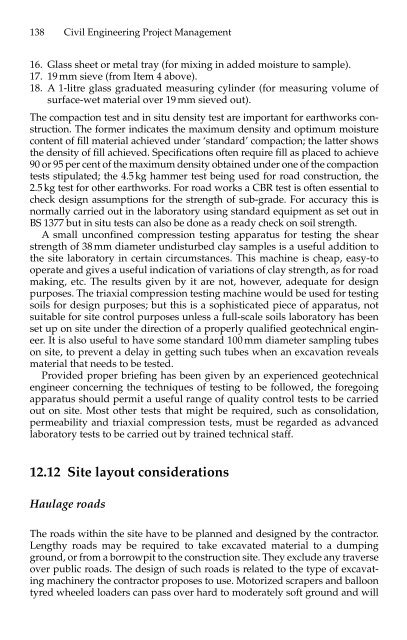Civil Engineering Project Management (4th Edition)
You also want an ePaper? Increase the reach of your titles
YUMPU automatically turns print PDFs into web optimized ePapers that Google loves.
138 <strong>Civil</strong> <strong>Engineering</strong> <strong>Project</strong> <strong>Management</strong><br />
16. Glass sheet or metal tray (for mixing in added moisture to sample).<br />
17. 19 mm sieve (from Item 4 above).<br />
18. A 1-litre glass graduated measuring cylinder (for measuring volume of<br />
surface-wet material over 19 mm sieved out).<br />
The compaction test and in situ density test are important for earthworks construction.<br />
The former indicates the maximum density and optimum moisture<br />
content of fill material achieved under ‘standard’ compaction; the latter shows<br />
the density of fill achieved. Specifications often require fill as placed to achieve<br />
90 or 95 per cent of the maximum density obtained under one of the compaction<br />
tests stipulated; the 4.5 kg hammer test being used for road construction, the<br />
2.5 kg test for other earthworks. For road works a CBR test is often essential to<br />
check design assumptions for the strength of sub-grade. For accuracy this is<br />
normally carried out in the laboratory using standard equipment as set out in<br />
BS 1377 but in situ tests can also be done as a ready check on soil strength.<br />
A small unconfined compression testing apparatus for testing the shear<br />
strength of 38 mm diameter undisturbed clay samples is a useful addition to<br />
the site laboratory in certain circumstances. This machine is cheap, easy-to<br />
operate and gives a useful indication of variations of clay strength, as for road<br />
making, etc. The results given by it are not, however, adequate for design<br />
purposes. The triaxial compression testing machine would be used for testing<br />
soils for design purposes; but this is a sophisticated piece of apparatus, not<br />
suitable for site control purposes unless a full-scale soils laboratory has been<br />
set up on site under the direction of a properly qualified geotechnical engineer.<br />
It is also useful to have some standard 100 mm diameter sampling tubes<br />
on site, to prevent a delay in getting such tubes when an excavation reveals<br />
material that needs to be tested.<br />
Provided proper briefing has been given by an experienced geotechnical<br />
engineer concerning the techniques of testing to be followed, the foregoing<br />
apparatus should permit a useful range of quality control tests to be carried<br />
out on site. Most other tests that might be required, such as consolidation,<br />
permeability and triaxial compression tests, must be regarded as advanced<br />
laboratory tests to be carried out by trained technical staff.<br />
12.12 Site layout considerations<br />
Haulage roads<br />
The roads within the site have to be planned and designed by the contractor.<br />
Lengthy roads may be required to take excavated material to a dumping<br />
ground, or from a borrowpit to the construction site. They exclude any traverse<br />
over public roads. The design of such roads is related to the type of excavating<br />
machinery the contractor proposes to use. Motorized scrapers and balloon<br />
tyred wheeled loaders can pass over hard to moderately soft ground and will


















